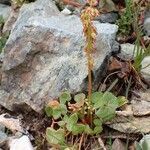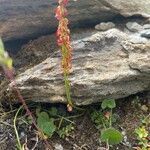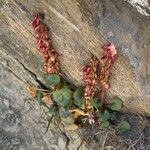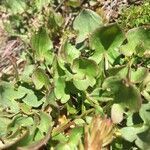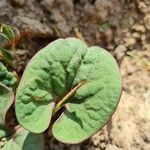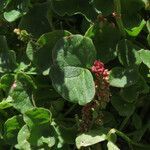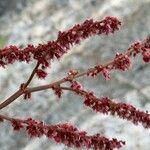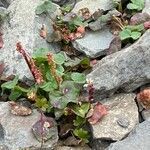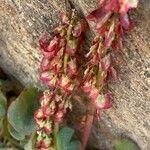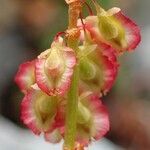Plants (3-)5-50 cm. Stems 1-4(-8), often reddish, simple or branched distally. Leaves rarely 1-2 on stems, somewhat fleshy; ocrea hyaline or brownish hyaline, 2.5-10 mm, glabrous; petiole 1-15 cm; blade palmately veined with (5-)7(-9) basal veins, 0.5-6.5 × 0.5-6 cm, base cordate, apex rounded. Inflorescences (1-)2-20 cm; peduncle 1-17 cm. Pedicels spreading or reflexed, jointed proximal to middle, (1-)3-5 mm. Flowers 2-6 per ocreate fascicle; perianth 1-2.5 mm; outer 2 tepals spreading in fruit, navicular, 1.2-1.7 × 0.5-1 mm, inner 2 tepals appressed in fruit, broadly elliptic to orbiculate or obovate, 1.4-2.5 × 0.7-1.6 mm; stamens 1.5-2 mm; anthers 0.3-0.8(-1.1) mm; stigmas conspicuously exserted at anthesis, red. Achenes 3-4.5 × 2.5-5 mm including 2 wings, apex notched; wings reddish or pinkish, veiny. 2n = 14.
A small herb. It keeps growing from year to year. It has a short rootstock 1 cm thick. It forms clumps. The leaf stems are long. The leaves are kidney-shaped and green and succulent. The leaves are mostly at the base and 2.5-5 cm across. The leaves are often tinted red. The stems have few leaves. The stems are 10-30 cm long and the flowers are green or reddish. They are 2 mm across. The fruit becomes red with papery wings. They are 6 mm across.
Stem 1–4 dm; lvs 3–5 cm long and wide, palmately veined; fls 1 mm; fr orbicular, 3–4 mm, turning red; 2n=14. Moist, rocky slopes and ledges; circumboreal, s. in our range to N.S. and n. N.H. Summer.
